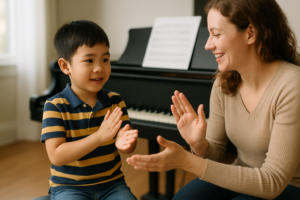As a collective of passionate music educators specializing in private lessons for beginners, we understand the importance of establishing a strong rhythmic foundation in piano students. One of the most effective methods we’ve found is practicing musical rhythms in piano lessons. This approach not only enhances timing and coordination but also fosters a deeper connection to the music.
1. Traditional Counting Techniques
Introducing students to traditional counting methods lays the groundwork for rhythmic understanding. By counting aloud (“one, two, three, four”) as they play, students begin to internalize the beat and comprehend the structure of measures. This practice aids in developing a steady tempo and reinforces the relationship between note values and their corresponding beats.
2. Incorporating Tapping and Metronomes
Utilizing tapping exercises and metronomes can significantly improve a student’s sense of timing. Tapping allows students to physically feel the beat, enhancing their kinesthetic awareness. Metronomes, on the other hand, provide a consistent tempo, challenging students to maintain rhythm without external cues. Combining these tools encourages students to develop an internal metronome, crucial for independent practice and performance.
3. Engaging with Rhythm Through Movement and Games
Integrating movement-based activities and rhythm games makes learning rhythm enjoyable and memorable. Clapping, marching, or using rhythm instruments can help students embody the beat, making abstract concepts tangible. Games that involve matching rhythms or creating rhythmic patterns promote active engagement and reinforce learning in a fun, interactive manner.
For more insights and resources on rhythm practice, explore our blog on practicing musical rhythms in piano lessons for kids.
Conclusion
Emphasizing practicing musical rhythms in piano lessons equips beginner students with the tools necessary for musical proficiency. Through traditional counting, tapping, metronome use, and interactive activities, students develop a solid rhythmic foundation, enhancing their overall musicality and confidence.
